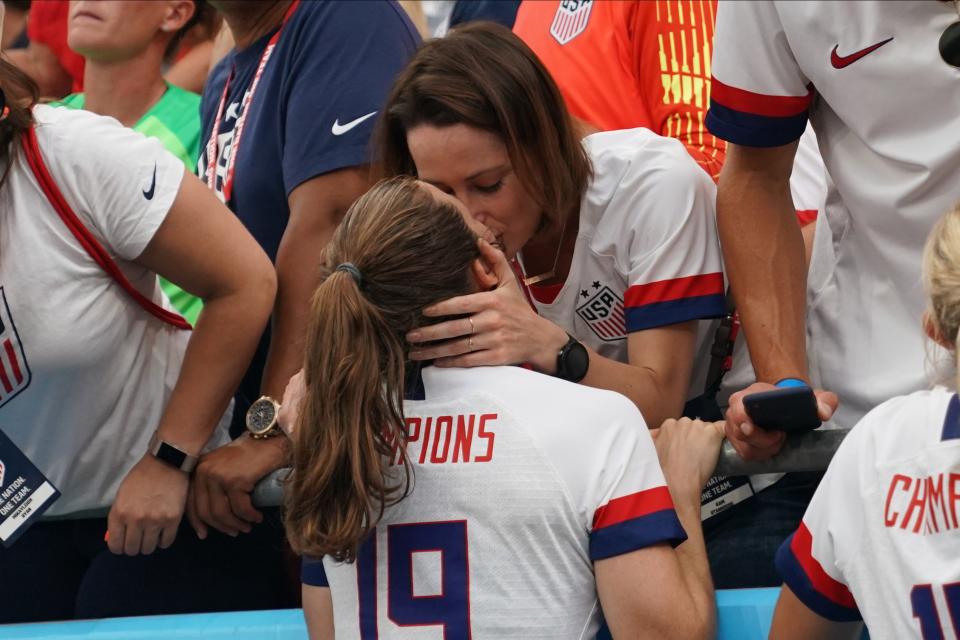This Is How You Come Out in 2019
This weekend the U.S. Women’s National Soccer Team nabbed their second consecutive World Cup—their fourth overall—making them the team with the most FIFA Women’s World Cup wins in history. It was truly a monumental day, but queer eyes were glued to the screen for other reasons too: namely, postgame celebratory kisses.
It’s no secret that the USWNT is spilling over with queerness. Cocaptain Megan Rapinoe's relationship with WNBA star Sue Bird has made headlines; teammates Ashlyn Harris and Ali Krieger are engaged; Jill Ellis, the team’s out lesbian coach, just became the first to win two World Cup titles. Yet with all this incredible visibility both on and off the field, one narrative struck me in a way I didn’t expect: Kelley O’Hara’s.
By now you may have seen the image of O’Hara—the team's defender and a Georgia native—kissing her girlfriend in the stands moments after her World Cup win:

United States of America v Netherlands : Final - 2019 FIFA Women's World Cup France
Daniela Porcelli/Getty ImagesThis stirred me for a few reasons. Mainly, O’Hara wasn’t publicly out before the World Cup the way Rapinoe, Harris, or Krieger were. Which means that moment served as her official coming-out, and a pretty nontraditional one. What really made my eyes run like a leaky faucet, though, was the deeper implication here. As long as I’ve been alive—and way before that—romance has been defined by heterosexual love. When I, a lesbian, think of iconic romantic kisses, a few images race through my mind: “VJ Day in Times Square,” the Vancouver riot’s kissing couple, Titanic, The Notebook, Sleeping Beauty. Hell, even those spaghetti-loving dogs are heterosexual in Lady & the Tramp.
As far as iconic kisses go, queer women don’t have many main-stage, historic moments.
Of course, I have my own manifesto of queer images stowed away in my brain: the Imagine Me & You kiss set to the Turtles’ “Happy Together,” the moment Alice and Dana dance together at the Planet in The L Word, the paparazzi photos of Cara Delevingne and Michelle Rodriguez drinking courtside at a Lakers game. But as far as iconic kisses go, queer women don’t have many main-stage, historic moments. And if we do, they’re not necessarily romantic even if they’re memorable for other reasons (see: Britney and Madonna, 2003 VMAs—a kiss that undoubtedly slaps).
This isn't just about media representation, which GLAAD reports is better than ever for LGBTQ+ storytelling on TV. I’m talking about the ways in which we’ve come to understand and learn about romance, which has throughout history been rooted in heterosexual love and gender roles. Even the way we think about a romantic kiss boils down to positioning and physicality—the height differences between a man and a woman, his ability to dip her, the way we picture her chin cocked upward or the way he wraps his arms around her waist.
I’ve always longed for the day when queer people didn’t have to unfurl a scroll, explaining when and where they realized they were queer.
When I saw the image of O’Hara, 30, kissing her girlfriend, it rocked me. This isn’t the first same-sex kiss on a world stage, but to know the story behind it is to understand its inherent romance. O’Hara had just won her second consecutive World Cup title—and just as we’ve seen male sports players do countless times, she ran to the sideline and kissed her girlfriend. The way her girlfriend held O’Hara’s face just about melted me into a pile of molten lesbian lava. What a uniquely 2019 way to come out as queer: to win your second consecutive World Cup title and kiss your girlfriend in front of all the cameras and screaming fans as though it was as matter-of-fact as any male athlete kissing his partner after a win. To me, that's a victory for queer women.
I’ve always longed for the day when queer people didn’t have to unfurl a scroll explaining when and where they realized they were queer. I’ve hoped that one day we would stop being outed, that we’d stop having to tearfully sit our parents down to have a tough conversation or screenshot the Notes App to outline our decision to write lyrics about same-sex lust (yes, this is a nod to Rita Ora). With O’Hara’s big postgame moment, I think we might finally be there.
O’Hara’s sideline kiss wasn’t bold. It was your humdrum, everyday postwin kiss, and that’s what makes it monumental.
As a sports fan, I think back on the way we’ve treated queer female athletes in the past. Like Billie Jean King, who was outed in a 1981 palimony lawsuit and eventually became the first female athlete to come out (before she was ready). Or Babe Didrikson Zaharias, an American gold medalist in the 1932 Summer Olympics who was criticized for her masculine appearance, married a man, and died of cancer with her female “companion” by her side. Or USC coach Pam Parsons, outed by a Sports Illustrated article in 1982; she sued and testified that she wasn’t gay and was later charged with perjury.
When I juxtapose those stories with O’Hara’s no-big-deal kiss, I think about how O’Hara wasn’t outed. That she didn’t need to make a written statement. How she didn’t face backlash. Instead, she received voracious praise from the queer community and USWNT fans. It makes my heart defrost a little.
This is my “VJ Day in Times Square.” This is how you come out in 2019: on the front lines of the fight for equal pay, after slaying on a once male-dominated field, surrounded by a pack of other badass women. O’Hara’s sideline kiss wasn’t bold. It was your humdrum, everyday postwin kiss, and that’s what makes it monumental.
Jill Gutowitz is a writer and comedian living in Los Angeles. Follow her on Twitter @jillboard.
Originally Appeared on Glamour

